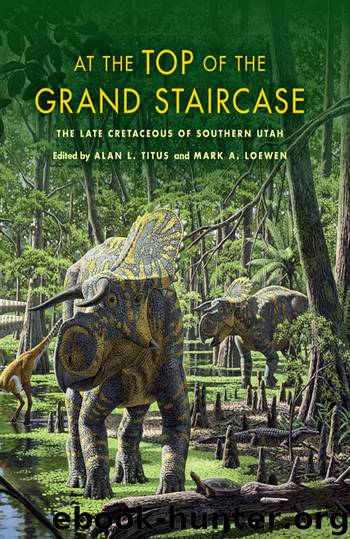At the Top of the Grand Staircase by Titus Alan L.;Loewen Mark A.;

Author:Titus, Alan L.;Loewen, Mark A.;
Language: eng
Format: epub
ISBN: 9780253008961
Publisher: Indiana University Press
Paleobiogeographic Implications
There has been considerable discussion of latitudinal differences in faunas, including mammalian assemblages (Gates et al., 2010). Certainly there is not a great overlap in mammalian species or even genera between Utah and Canada (Table 14.1); however, there are several taxa that are conspecific or conferred. This may indicate that strong latitudinal taxonomic gradients were present affecting the distribution of mammalian taxa.
Although this may well have played a role, small mammals are good at partitioning niches and having relatively small ranges that may reflect controls other than latitude. Late Cretaceous faunas have been described from the Paunsaugunt (Eaton, 1993b) and Markagunt (Eaton, 2006b, 2009) plateaus west of Kaiparowits region. The stratigraphy from the Kaiparowits Plateau can be carried into the Paunsaugunt Plateau, but the stratigraphy of the Markagunt Plateau is far less certain (Eaton et al., 2001). Although the stratigraphic relations of the Kaiparowits and Paunsaugunt plateaus are known (Fig. 14.2), the mammalian faunas of these two adjacent plateaus have no species in common. There are most certainly Santonian and possibly Campanian fossil-bearing horizons on the Markagunt Plateau. Eaton (this volume, Chapter 15) has recently compared large new collections of Santonian material from Bryce Canyon National Park and all previously described Paunsaugunt and Kaiparowits plateaus mammals recovered from the Wahweap Formation, and there is not a single certainly conspecific taxon. He has also compared this new Santonian fauna to potentially correlative faunas on the Markagunt Plateau described in Eaton (2006b), and again, there are no conspecific taxa and the faunas are remarkably different. This represents either the sampling of different time intervals (to some degree likely between all faunal comparisons) or strong lateral changes in mammalian faunal composition. The floodplain sediments are distinctly different from east to west, with dark, organic-rich coastal floodplains to the east and better-drained, more upland variegated floodplains to the west. These subtle lateral changes in facies may reflect ecologic differences that may have a strong impact on the distribution of mammalian taxa, perhaps as marked as latitudinal changes.
Download
This site does not store any files on its server. We only index and link to content provided by other sites. Please contact the content providers to delete copyright contents if any and email us, we'll remove relevant links or contents immediately.
Man-made Catastrophes and Risk Information Concealment by Dmitry Chernov & Didier Sornette(5630)
The Revenge of Geography: What the Map Tells Us About Coming Conflicts and the Battle Against Fate by Kaplan Robert D(3943)
Zero Waste Home by Bea Johnson(3643)
In a Sunburned Country by Bill Bryson(3350)
Good by S. Walden(3338)
COSMOS by Carl Sagan(3334)
The Fate of Rome: Climate, Disease, and the End of an Empire (The Princeton History of the Ancient World) by Kyle Harper(2850)
Camino Island by John Grisham(2710)
A Wilder Time by William E. Glassley(2682)
Organic Mushroom Farming and Mycoremediation by Tradd Cotter(2556)
The Ogre by Doug Scott(2491)
Human Dynamics Research in Smart and Connected Communities by Shih-Lung Shaw & Daniel Sui(2427)
Energy Myths and Realities by Vaclav Smil(2373)
The Traveler's Gift by Andy Andrews(2294)
9781803241661-PYTHON FOR ARCGIS PRO by Unknown(2262)
Inside the Middle East by Avi Melamed(2228)
Birds of New Guinea by Pratt Thane K.; Beehler Bruce M.; Anderton John C(2169)
A History of Warfare by John Keegan(2086)
Ultimate Navigation Manual by Lyle Brotherton(2035)
